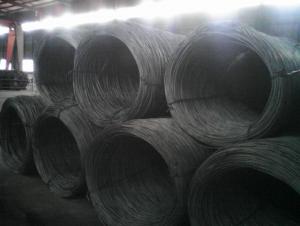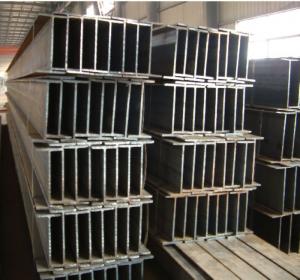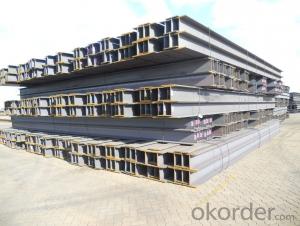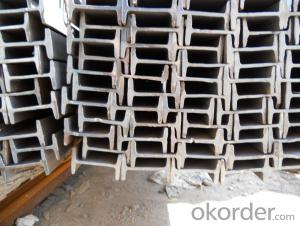H Beam
- Loading Port:
- China Main Port
- Payment Terms:
- TT OR LC
- Min Order Qty:
- -
- Supply Capability:
- 10000 m.t./month
OKorder Service Pledge
OKorder Financial Service
You Might Also Like
Product Description:
Specifications of Hot Rolled Structural Steel H Beam
1. Standard: GB700-88, Q235B2.
2. Grade: Q235, SS400 or Equivalent
3. Length: 6m,10m, 12m as following table
4. Invoicing on theoretical weight or actual weight as customer request
5.Payment: TT or L/C
6. Sizes:
SIZE(mm) | DIMENSION(kg/m) |
100*100 | 16.9 |
125*125 | 23.6 |
150*75 | 14 |
150*150 | 31.1 |
148*100 | 20.7 |
198*99 | 17.8 |
200*100 | 20.9 |
248*124 | 25.1 |
250*125 | 29 |
Usage & Applications of Hot Rolled Structural Steel H Beam
Commercial building structure ;Pre-engineered buildings; Machinery support structure; Prefabricated structure; Medium scale bridges; Ship-building structure. etc.
Packaging & Delivery of Hot Rolled Structural Steel H Beam
1. Packing: it is nude packed in bundles by steel wire rod
2. Bundle weight: not more than 3.5MT for bulk vessel; less than 3 MT for container load
3. Marks:
Color marking: There will be color marking on both end of the bundle for the cargo delivered by bulk vessel. That makes it easily to distinguish at the destination port.
Tag mark: there will be tag mark tied up on the bundles. The information usually including supplier logo and name, product name, made in China, shipping marks and other information request by the customer.
If loading by container the marking is not needed, but we will prepare it as customer request.
4. Transportation: the goods are delivered by truck from mill to loading port, the maximum quantity can be loaded is around 40MTs by each truck. If the order quantity cannot reach the full truck loaded, the transportation cost per ton will be little higher than full load.
5. Delivered by container or bulk vessel
Production flow of Hot Rolled Structural Steel H Beam
Material prepare (billet) —heat up—rough rolling—precision rolling—cooling—packing—storage and transportation
- Q: How do steel H-beams perform in areas with high levels of air pollution or chemical exposure?
- Steel H-beams are highly durable and resistant to corrosion, making them well-suited for areas with high levels of air pollution or chemical exposure. The steel used in H-beams is typically coated with protective layers such as galvanization or paint, which provide an additional barrier against corrosive substances in the air or chemicals. These protective coatings prevent the steel from reacting with pollutants or corrosive agents, ensuring the structural integrity and longevity of H-beams even in harsh environments. Additionally, the sturdy design of H-beams, with their cross-sectional shape providing excellent strength and load-bearing capacity, further enhances their performance in areas with high pollution or chemical exposure. Overall, steel H-beams are a reliable and robust choice for construction projects in such areas, offering long-lasting performance and resistance to corrosion.
- Q: What are the different grades of Steel H-Beams available?
- In the market, one can find various grades of Steel H-Beams. A36, A572, and A992 are among the most frequently utilized grades. A36, widely employed for general structural purposes, is a low carbon steel. It possesses a yield strength of 36,000 psi and a tensile strength ranging from 58,000 to 80,000 psi. Construction projects, bridges, and machinery often utilize A36 H-Beams. A572, on the other hand, is a high-strength, low-alloy steel that surpasses A36 in terms of strength and hardness. It has a yield strength of 42,000 to 65,000 psi and a tensile strength of 60,000 to 80,000 psi. A572 H-Beams are commonly found in heavy construction, infrastructure development, and projects necessitating high strength. A992, a widely used structural steel grade, boasts superior mechanical properties. It possesses a yield strength of 50,000 to 65,000 psi and a tensile strength of 65,000 to 85,000 psi. High-rise buildings, bridges, and demanding applications that require exceptional strength and stability often employ A992 H-Beams. Less commonly used grades of Steel H-Beams include A588, A514, and A709, each offering specific properties and characteristics suitable for particular applications. To determine the most suitable grade of Steel H-Beams for a specific project or application, it is crucial to consult with a steel supplier or engineer.
- Q: How do steel H-beams perform in structures with heavy machinery and equipment?
- Structures that incorporate heavy machinery and equipment greatly benefit from the exceptional performance of steel H-beams. H-beams possess a distinctive design that efficiently withstands the significant loads and stresses commonly associated with heavy machinery and equipment. The horizontal flanges of H-beams offer excellent resistance against bending and twisting forces, making them an ideal choice for supporting heavy loads. Additionally, the vertical web functions as a stiffener, providing superior strength and stability to the structure. Furthermore, steel H-beams exhibit high tensile strength, enabling them to withstand the dynamic loads generated by heavy machinery and equipment. Consequently, this ensures a safer working environment by minimizing the risk of structural failure or collapse. Regarding durability, steel H-beams display remarkable resistance to deformation, corrosion, and other environmental factors. This guarantees their long-term performance, even in demanding industrial settings. Moreover, steel H-beams are easily fabricated and installed, contributing to their popularity in structures with heavy machinery and equipment. Their versatility allows for efficient construction and adaptability to various design requirements. In conclusion, steel H-beams prove to be an excellent choice for structures incorporating heavy machinery and equipment. Their unique design, high strength, and durability equip them to withstand the significant loads and stresses associated with such applications.
- Q: Can steel H-beams be used for religious buildings?
- Yes, steel H-beams can be used for religious buildings. Steel is a versatile and durable material that can provide structural support for various types of buildings, including religious structures. The use of steel H-beams can offer strength, stability, and flexibility in the design and construction of religious buildings, allowing for innovative architectural solutions while ensuring structural integrity.
- Q: Are steel H-beams resistant to chemicals or corrosive substances?
- Yes, steel H-beams are generally resistant to chemicals and corrosive substances due to their composition and protective coatings. However, the level of resistance can vary depending on the specific type of steel and the nature of the chemical or corrosive substance involved. It is important to consider the specific application and consult with experts to ensure proper corrosion protection measures are in place.
- Q: What are the different types of coatings available for steel H-beams?
- There are several different types of coatings available for steel H-beams, including galvanized coating, epoxy coating, powder coating, and paint coating. Each type of coating provides specific benefits such as corrosion resistance, improved aesthetics, and enhanced durability, allowing H-beams to withstand various environmental conditions and extend their lifespan. The choice of coating depends on the specific requirements of the project and the desired performance characteristics.
- Q: How do steel H-beams perform in vibration-prone environments?
- Steel H-beams have gained a reputation for their exceptional performance in environments prone to vibrations. The distinctive design of H-beams, characterized by their wide flanges and vertical web, grants them superior rigidity and strength, resulting in a high resistance to vibrations. This structural shape effectively distributes the load evenly, minimizing the impact of vibrations on the beam. The utilization of steel as the material for H-beams ensures remarkable durability and stability, making them especially suitable for environments where vibrations are prevalent. Steel possesses a high modulus of elasticity, enabling it to endure and absorb vibrations without experiencing significant deformation or damage. This property establishes steel H-beams as a dependable choice for structures exposed to dynamic loads, including bridges, high-rise buildings, and industrial facilities. Moreover, steel H-beams can be customized with additional measures to enhance their performance in vibration-prone environments. These measures encompass options such as thicker flanges, increased beam depth, or the inclusion of damping materials. By implementing these measures, the H-beams can further mitigate vibrations and minimize their impact on the overall structure. In conclusion, the inherent strength, rigidity, and durability of steel H-beams make them well-suited for environments susceptible to vibrations. Their distinctive design and properties empower them to endure vibrations without compromising the stability of the structure. When appropriately designed and executed, steel H-beams offer a reliable and efficient solution for structures that must excel in such challenging conditions.
- Q: Can steel H-beams be used in gymnasium structures?
- Yes, steel H-beams can be used in gymnasium structures. Steel H-beams are commonly used in construction due to their high strength and durability. They provide excellent support and stability, making them suitable for large open spaces like gymnasiums. Additionally, steel H-beams can be easily fabricated and customized to fit the specific design requirements of a gymnasium. They can withstand heavy loads and provide the necessary structural integrity needed for gymnasium structures.
- Q: How do steel H-beams perform in areas with high wind loads?
- In areas with high wind loads, steel H-beams exhibit exceptional performance. The H-shaped design of these beams imparts remarkable strength and stability, rendering them highly impervious to lateral forces generated by powerful winds. The structural integrity of steel H-beams facilitates the uniform distribution of wind load throughout the entire beam, thereby minimizing the likelihood of failure or deformation. Moreover, steel possesses enduring qualities and pliability, further augmenting its efficacy in regions prone to strong winds. The elevated tensile strength of steel empowers it to endure the force exerted by powerful winds, providing outstanding resistance against bending or buckling. All in all, steel H-beams represent an ideal selection for construction projects in areas with high wind loads, as they furnish dependable and enduring support to structures in such circumstances.
- Q: How to process arc H steel?
- See you is an arc in which direction the ah, if it is directly under the arc arc flange flange welded web on the line, the web is on the web flange welding arc. There are two directions are arc. Hope to help you.
Send your message to us
H Beam
- Loading Port:
- China Main Port
- Payment Terms:
- TT OR LC
- Min Order Qty:
- -
- Supply Capability:
- 10000 m.t./month
OKorder Service Pledge
OKorder Financial Service
Similar products
Hot products
Hot Searches
Related keywords






























